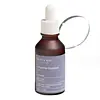What's inside
What's inside
 Key Ingredients
Key Ingredients

 Benefits
Benefits

 Concerns
Concerns

No concerns
 Ingredients Side-by-side
Ingredients Side-by-side

Water
Skin ConditioningGlycerin
HumectantHeptyl Glucoside
Isodecyl Neopentanoate
EmollientAcacia Senegal Gum
MaskingPolysorbate 20
EmulsifyingCentella Asiatica Leaf Extract
Skin ConditioningHelianthus Annuus Seed Oil
EmollientTocopherol
AntioxidantPhospholipids
Skin ConditioningGlycolipids
Skin ConditioningDimethyl Sulfone
SolventOrnithine
Skin ConditioningLecithin
EmollientHydrogenated Lecithin
EmulsifyingCopper Lysinate/Prolinate
Skin ConditioningMethylglucoside Phosphate
Skin ConditioningCrocus Chrysanthus Bulb Extract
Skin ConditioningSh-Oligopeptide-1
Skin ConditioningDipeptide Diaminobutyroyl Benzylamide Diacetate
Skin ConditioningPentapeptide-18
Skin ConditioningPentapeptide-48
Skin ConditioningButyrospermum Parkii Butter
Skin ConditioningLeuconostoc/Radish Root Ferment Filtrate
AntimicrobialCaprylic/Capric Triglyceride
MaskingEthylhexylglycerin
Skin ConditioningC12-15 Alkyl Benzoate
AntimicrobialSclerotium Gum
Emulsion StabilisingXanthan Gum
EmulsifyingCaprylyl Glycol
EmollientLevulinic Acid
PerfumingP-Anisic Acid
MaskingSodium Gluconate
Skin ConditioningPropanediol
SolventMaltodextrin
AbsorbentCitric Acid
BufferingSodium Hydroxide
BufferingHeptanol
PerfumingPhenethyl Alcohol
MaskingPhenoxyethanol
PreservativeWater, Glycerin, Heptyl Glucoside, Isodecyl Neopentanoate, Acacia Senegal Gum, Polysorbate 20, Centella Asiatica Leaf Extract, Helianthus Annuus Seed Oil, Tocopherol, Phospholipids, Glycolipids, Dimethyl Sulfone, Ornithine, Lecithin, Hydrogenated Lecithin, Copper Lysinate/Prolinate, Methylglucoside Phosphate, Crocus Chrysanthus Bulb Extract, Sh-Oligopeptide-1, Dipeptide Diaminobutyroyl Benzylamide Diacetate, Pentapeptide-18, Pentapeptide-48, Butyrospermum Parkii Butter, Leuconostoc/Radish Root Ferment Filtrate, Caprylic/Capric Triglyceride, Ethylhexylglycerin, C12-15 Alkyl Benzoate, Sclerotium Gum, Xanthan Gum, Caprylyl Glycol, Levulinic Acid, P-Anisic Acid, Sodium Gluconate, Propanediol, Maltodextrin, Citric Acid, Sodium Hydroxide, Heptanol, Phenethyl Alcohol, Phenoxyethanol
Water
Skin ConditioningGlycereth-26
Humectant1,2-Hexanediol
Skin ConditioningButylene Glycol
HumectantGlycerin
HumectantArginine
MaskingCarbomer
Emulsion StabilisingEthylhexylglycerin
Skin ConditioningPolyglyceryl-10 Laurate
Skin ConditioningAdenosine
Skin ConditioningCaprylyl Glycol
EmollientCopper Tripeptide-1
Skin ConditioningHexapeptide-11
Skin ConditioningHexapeptide-9
Skin ConditioningPalmitoyl Pentapeptide-4
Skin ConditioningPalmitoyl Tripeptide-1
Skin ConditioningTripeptide-1
Skin Conditioning
 Reviews
Reviews

Ingredients Explained
These ingredients are found in both products.
Ingredients higher up in an ingredient list are typically present in a larger amount.
Caprylyl Glycol is a humectant and emollient, meaning it attracts and preserves moisture.
It is a common ingredient in many products, especially those designed to hydrate skin. The primary benefits are retaining moisture, skin softening, and promoting a healthy skin barrier.
Though Caprylyl Glycol is an alcohol derived from fatty acids, it is not the kind that can dry out skin.
This ingredient is also used as a preservative to extend the life of products. It has slight antimicrobial properties.
Learn more about Caprylyl GlycolEthylhexylglycerin (we can't pronounce this either) is commonly used as a preservative and skin softener. It is derived from glyceryl.
You might see Ethylhexylglycerin often paired with other preservatives such as phenoxyethanol. Ethylhexylglycerin has been found to increase the effectiveness of these other preservatives.
Glycerin is already naturally found in your skin. It helps moisturize and protect your skin.
A study from 2016 found glycerin to be more effective as a humectant than AHAs and hyaluronic acid.
As a humectant, it helps the skin stay hydrated by pulling moisture to your skin. The low molecular weight of glycerin allows it to pull moisture into the deeper layers of your skin.
Hydrated skin improves your skin barrier; Your skin barrier helps protect against irritants and bacteria.
Glycerin has also been found to have antimicrobial and antiviral properties. Due to these properties, glycerin is often used in wound and burn treatments.
In cosmetics, glycerin is usually derived from plants such as soybean or palm. However, it can also be sourced from animals, such as tallow or animal fat.
This ingredient is organic, colorless, odorless, and non-toxic.
Glycerin is the name for this ingredient in American English. British English uses Glycerol/Glycerine.
Learn more about GlycerinWater. It's the most common cosmetic ingredient of all. You'll usually see it at the top of ingredient lists, meaning that it makes up the largest part of the product.
So why is it so popular? Water most often acts as a solvent - this means that it helps dissolve other ingredients into the formulation.
You'll also recognize water as that liquid we all need to stay alive. If you see this, drink a glass of water. Stay hydrated!
Learn more about Water